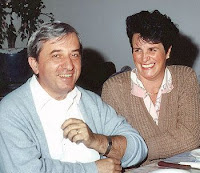Two months ago our family doctor of 30 years retired. He was a rare specimen in our modern age of doctors who rely too much on technology and not enough on their instinct. His favorite saying was: it’s your body, listen to it. While I am not sure he was a saint, he was compassionate and generous, never rushing with you and had the ability to make you feel you were his favorite patient. This month I would like to focus on some very special doctors in our modern Church.
Amazingly, as I was preparing a Blog on two new Venerables, both of whom were physicians, the Holy Father on May 28 , met with members of the International Federation of Associations of Catholic Physicians ahead of a congress on the theme of “Holiness of life and the medical profession, from Humanae vitae to Laudato si'” in Zagreb, Croatia May 30-June 2.
 |
| Jesus Healing |
Amazingly, as I was preparing a Blog on two new Venerables, both of whom were physicians, the Holy Father on May 28 , met with members of the International Federation of Associations of Catholic Physicians ahead of a congress on the theme of “Holiness of life and the medical profession, from Humanae vitae to Laudato si'” in Zagreb, Croatia May 30-June 2.
He noted the “hardships and difficulties” physicians may face when they are faithful to the teachings of the Catholic Church, particularly when they promote and defend human life “from its conception to its natural end.”
Doctors “are called to affirm the centrality of the patient as a person and his dignity with his inalienable rights, primarily the right to life. The tendency to debase the sick man as a machine to be repaired, without respect for moral principles, and to exploit the weakest by discarding what does not correspond to the ideology of efficiency and profit must be resisted.”
To be a Catholic doctor means to feel driven by “faith and from communion with the Church” to grow in Christian and professional formation and to know the laws of nature in order “to better serve life,” he said, stressing that the participation of Catholic physicians in the life and mission of the Church is “so necessary.”
“Be more and more aware that today it is necessary and urgent that the action of the Catholic physician presents itself with an unmistakable clarity on the level of personal and associative testimony,” he urged.
He also encouraged working together with professionals of other religious convictions who also recognize the dignity of the human person, and with priests and religious who work in the healthcare field.
Continue the journey “with joy and generosity,” he said, “in collaboration with all the people and institutions that share the love of life and endeavor to serve it in its dignity and sacredness.”
One doctor who certainly fulfilled in his professional life as well as his spiritual life the virtues our Holy Father calls for in the medical profession was VENERABLE VITTORIO TRANCANELLI, a married layman and surgeon, who was known as “the Saint of the Operating Room.” Born in Perugia , Italy
He studied medicine in Perugia Italy , which was incorporated into an expanding Roman Empire during the period of Rome
He married Rosalia Sabatini in 1965 and became quite ill in 1976 prior to the birth of his son Diego. His illness returned in 1981 before the birth of his second child. He and his wife adopted seven others with some of them being disabled and formed an association of families who adopted disadvantaged children.
He gained a strong reputation for both his good work as a doctor and for his personal holiness which was evident in his interactions with people he worked with. He was dubbed "The Saint of the Operating Room".
Venerable Vittorio was enthralled with Judaism, as Jesus Christ was a Jew, and contributed to Jewish festivals and attempted to learn the language. He was a frequent contributor to the Ecumenical Centre of St Martin where the elders there dubbed him as "our rabbi".
 He had an operation for ulcerative colitis which had developed into peritonitis.He became ill in March 1998 and died three months later on 24 June 1998.
He had an operation for ulcerative colitis which had developed into peritonitis.He became ill in March 1998 and died three months later on 24 June 1998.Archbishop Giuseppe Chiaretti celebrated the funeral mass in which his coffin was draped with a tallit (prayer shawl) due to his love for the Jewish people. A great number of people and those of the Jewish faith attended. The archbishop referred to Vittorio as a "saint of our time" who espoused a "civilization of love". One can see from the photos that he radiated the joy of His beloved Lord.

